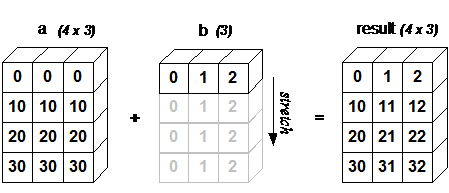Numpy基础知识
Numpy
Ndarray对象
numpy.array(object, dtype=None, copy=True, order=None, subok=False, ndmin=0)
E.g.1:
import numpy as np
a = np.array([1, 2, 3])
print(a)
[1 2 3]
E.g.2:
# 多一个维度
import numpy as np
a = np.array([[1, 2], [3, 4]])
print(a)
[[1 2]
[3 4]]
E.g.3:
# 最小维度
import numpy as np
a = np.array([1, 2, 3, 4, 5], ndmin=2)
print(a)
[[1 2 3 4 5]]
E.g.4:
# dtype 参数
import numpy as np
a = np.array([1, 2, 3], dtype=complex)
print(a)
[1.+0.j 2.+0.j 3.+0.j]
NumPy数据类型
dtype(obj, align=False, copy=False)
E.g.1:
import numpy as np
# 使用标量类型
dt = np.dtype(np.int32)
print(dt)
int32
E.g.2:
import numpy as np
# int8, int16, int32, int64 四种数据类型可以使用字符串 'i1', 'i2','i4','i8' 代替
dt = np.dtype('i4')
print(dt)
int32
E.g.3:
import numpy as np
# 字节顺序标注
dt = np.dtype('<i4')
print(dt)
int32
E.g.4:
# 首先创建结构化数据类型
import numpy as np
dt = np.dtype([('age', np.int8)])
print(dt)
[('age', 'i1')]
E.g.5:
# 将数据类型应用于 ndarray 对象
import numpy as np
dt = np.dtype([('age', np.int8)])
a = np.array([(10,), (20,), (30,)], dtype=dt)
print(a)
[(10,) (20,) (30,)]
E.g.6:
# 类型字段名可以用于存取实际的 age 列
import numpy as np
dt = np.dtype([('age',np.int8)])
a = np.array([(10,),(20,),(30,)], dtype = dt)
print(a['age'])
[10 20 30]
E.g.7:
import numpy as np
student = np.dtype([('name', 'S20'), ('age', 'i1'), ('marks', 'f4')])
a = np.array([('abc', 21, 50), ('xyz', 18, 75)], dtype=student)
print(student)
print(a)
print(a['age'])
print(a['marks'])
print(a[0])
print(a[0][1])
[('name', 'S20'), ('age', 'i1'), ('marks', '<f4')]
[(b'abc', 21, 50.) (b'xyz', 18, 75.)]
[21 18]
[50. 75.]
(b'abc', 21, 50.)
21
NumPy数组属性
ndarray.ndim
- 用于返回数组的维数,等于秩。
E.g.1:
import numpy as np
a = np.arange(24)
print(a.ndim) # a 现只有一个维度
print(a)
# 现在调整其大小
b = a.reshape(2, 4, 3) # b 现在拥有三个维度
print(b.ndim)
print(b)
1
[ 0 1 2 3 4 5 6 7 8 9 10 11 12 13 14 15 16 17 18 19 20 21 22 23]
3
[[[ 0 1 2]
[ 3 4 5]
[ 6 7 8]
[ 9 10 11]]
[[12 13 14]
[15 16 17]
[18 19 20]
[21 22 23]]]
ndarray.shape
- ndarray.shape 表示数组的维度,返回一个元组,这个元组的长度就是维度的数目,即 ndim 属性(秩)。比如,一个二维数组,其维度表示"行数"和"列数"。
E.g.1:
import numpy as np
a = np.array([[1, 2, 3], [4, 5, 6]])
print(a.shape)
(2, 3)
- ndarray.shape 也可以用于调整数组大小。
E.g.2:
import numpy as np
a = np.array([[1, 2, 3], [4, 5, 6]])
a.shape = (3, 2)
print(a)
[[1 2]
[3 4]
[5 6]]
- NumPy 也提供了 reshape 函数来调整数组大小。
import numpy as np
a = np.array([[1, 2, 3], [4, 5, 6]])
b = a.reshape(3, 2)
print(b)
[[1 2]
[3 4]
[5 6]]
ndarray.itemsize
- ndarray.itemsize 以字节的形式返回数组中每一个元素的大小。
import numpy as np
# 数组的 dtype 为 int8(一个字节)
x = np.array([1, 2, 3, 4, 5], dtype=np.int8)
print(x.itemsize)
# 数组的 dtype 现在为 float64(八个字节)
y = np.array([1, 2, 3, 4, 5], dtype=np.float64)
print(y.itemsize)
1
8
NumPy创建数组
ndarray 数组除了可以使用底层 ndarray 构造器来创建外,也可以通过以下几种方式来创建。
numpy.empty
- numpy.empty 方法用来创建一个指定形状(shape)、数据类型(dtype)且未初始化的数组
numpy.empty(shape, dtype = float, order = 'C')
E.g.1:
import numpy as np
x = np.empty([3, 3], dtype=int)
print(x)
[[1101547904 543 1101542240]
[ 543 1101548592 543]
[1101549312 543 1101549312]]
注意:数组元素为随机值,因为它们未初始化。
numpy.zeros
- 创建指定大小的数组,数组元素以 0 来填充
numpy.zeros(shape, dtype = float, order = 'C')
import numpy as np
# 默认为浮点数
x = np.zeros(5)
print(x)
# 设置类型为整数
y = np.zeros((5,), dtype=np.int)
print(y)
# 自定义类型
z = np.zeros((2, 2), dtype=[('x', 'i4'), ('y', 'i4')])
print(z)
[0. 0. 0. 0. 0.]
[0 0 0 0 0]
[[(0, 0) (0, 0)]
[(0, 0) (0, 0)]]
numpy.ones
- 创建指定形状的数组,数组元素以 1 来填充
numpy.ones(shape, dtype = None, order = 'C')
import numpy as np
# 默认为浮点数
x = np.ones(5)
print(x)
# 自定义类型
x = np.ones([2, 2], dtype=int)
print(x)
[1. 1. 1. 1. 1.]
[[1 1]
[1 1]]
numpy.asarray
- numpy.asarray 类似 numpy.array,但 numpy.asarray 参数只有三个,比 numpy.array 少两个。
numpy.asarray(a, dtype = None, order = None)
E.g.1:
import numpy as np
x = [1, 2, 3]
a = np.asarray(x)
print(a)
[1 2 3]
E.g.2:
import numpy as np
x = (1, 2, 3)
a = np.asarray(x)
print(a)
[1 2 3]
E.g.3:
- 将元组列表转换为 ndarray
import numpy as np
x = [(1, 2, 3), (4, 5)]
a = np.asarray(x)
print(a)
print(a.shape)
[(1, 2, 3) (4, 5)]
(2,)
E.g.4:
- 设置了 dtype 参数
import numpy as np
x = [1, 2, 3]
a = np.asarray(x, dtype=float)
print(a)
[1. 2. 3.]
numpy.arange
numpy.arange(start, stop, step, dtype)
- 根据 start 与 stop 指定的范围以及 step 设定的步长,生成一个 ndarray。
E.g.1:
import numpy as np
x = np.arange(5)
print(x)
[0 1 2 3 4]
E.g.2:
import numpy as np
# 设置了 dtype
x = np.arange(5, dtype=float)
print(x)
[0. 1. 2. 3. 4.]
E.g.3:
- 设置了起始值、终止值及步长
import numpy as np
x = np.arange(10, 20, 2)
print(x)
[10 12 14 16 18]
numpy.linspace
- numpy.linspace 函数用于创建一个一维数组,数组是一个等差数列构成的
np.linspace(start, stop, num=50, endpoint=True, retstep=False, dtype=None)
E.g.1:
import numpy as np
a = np.linspace(1, 10, 10)
print(a)
[ 1. 2. 3. 4. 5. 6. 7. 8. 9. 10.]
E.g.2:
import numpy as np
a = np.linspace(1, 1, 10)
print(a)
[1. 1. 1. 1. 1. 1. 1. 1. 1. 1.]
E.g.3:
import numpy as np
a = np.linspace(10, 20, 5, endpoint=False)
print(a)
[10. 12. 14. 16. 18.]
注意:如果将 endpoint 设为 true,则会包含 20。
E.g.4:
import numpy as np
a = np.linspace(1, 10, 10, retstep=True)
print(a)
(array([ 1., 2., 3., 4., 5., 6., 7., 8., 9., 10.]), 1.0)
NumPy广播机制
- 广播(Broadcast)是 numpy 对不同形状(shape)的数组进行数值计算的方式, 对数组的算术运算通常在相应的元素上进行。如果两个数组 a 和 b 形状相同,即满足 a.shape == b.shape,那么 a*b 的结果就是 a 与 b 数组对应位相乘。这要求维数相同,且各维度的长度相同。
E.g.1:
import numpy as np
a = np.array([1.0, 2.0, 3.0])
b = np.array([2.0, 2.0, 2.0])
print(a * b)
[2. 4. 6.]
E.g.2:
- 最简单的使用广播机制的方式
import numpy as np
a = np.array([1.0, 2.0, 3.0])
b = 2.0
print(a * b)
[2. 4. 6.]
E.g.3:
import numpy as np
a = np.array([[0, 0, 0],
[10, 10, 10],
[20, 20, 20],
[30, 30, 30]])
b = np.array([0, 1, 2])
print(a + b)
[[ 0 1 2]
[10 11 12]
[20 21 22]
[30 31 32]]

E.g.4:
- Broadcast 提供了一种更便捷的计算方式
import numpy as np
a = np.array([0, 10, 20, 30])
b = np.array([0, 1, 2])
print(a[:, np.newaxis] + b)
[[ 0 1 2]
[10 11 12]
[20 21 22]
[30 31 32]]

NumPy矩阵运算
np.empty()
empty(shape, dtype=float, order='C'])
E.g.1:
import numpy as np
print(np.empty((2, 4)))
[[0.00000000e+000 0.00000000e+000 0.00000000e+000 0.00000000e+000]
[0.00000000e+000 1.32409593e-321 7.56599127e-307 2.22522596e-306]]
np.zeros
- np.zeros 函数创建一个以 0 填充的矩阵。
zeros(shape, dtype=float, order='C')
E.g.1:
import numpy as np
print(np.zeros((2, 2)))
[[0. 0.]
[0. 0.]]
np.ones
- np.zeros 函数创建一个以 1 填充的矩阵。
numpy.ones(shape, dtype=None, order='C')
E.g.1:
import numpy as np
print(np.ones((2, 2)))
[[1. 1.]
[1. 1.]]
np.eye
- np.eye 函数返回一个矩阵,对角线元素为 1,其他位置为零。
eye(N, M=None, k=0, dtype=<class 'float'>, order='C')
参数说明:
- N: 返回矩阵的行数
- M: 返回矩阵的列数,默认为N
- k: 对角线的索引
- dtype: 数据类型
E.g.1:
import numpy as np
print(np.eye(N=3, M=4, k=0, dtype=float))
print()
print(np.eye(N=3, M=4, k=1, dtype=float))
[[1. 0. 0. 0.]
[0. 1. 0. 0.]
[0. 0. 1. 0.]]
[[0. 1. 0. 0.]
[0. 0. 1. 0.]
[0. 0. 0. 1.]]
np.identity
- np.identity 函数返回给定大小的单位矩阵。

E.g.1:
import numpy as np
print(np.identity(5, dtype=float))
[[1. 0. 0. 0. 0.]
[0. 1. 0. 0. 0.]
[0. 0. 1. 0. 0.]
[0. 0. 0. 1. 0.]
[0. 0. 0. 0. 1.]]
np.random.rand
- np.random.rand 函数创建一个给定大小的矩阵,数据是随机填充的。
E.g.1:
import numpy as np
print(np.random.rand(3, 3))
[[0.57827876 0.79415739 0.13667962]
[0.74563301 0.8233452 0.13949766]
[0.40467766 0.78520166 0.31664313]]
np.matmul
- np.matmul 函数返回两个数组的矩阵乘积。对于二维数组,它就是矩阵乘法
E.g.1:
import numpy as np
a = [[1, 0], [0, 1]]
b = [[4, 1], [2, 2]]
print(np.matmul(a, b))
[[4 1]
[2 2]]
- 另一方面,如果任意参数是一维数组,则通过在其维度上附加1来将其提升为矩阵,并在乘法之后被去除。
E.g.2:
import numpy as np
a = [[1, 2], [3, 4]]
b = [1, 2]
print(np.matmul(a, b))
print(np.matmul(b, a))
[ 5 11]
[ 7 10]
- 如果任一参数的维数大于2,则将其视为存在于最后两个索引的矩阵的栈,并进行相应广播。
E.g.3:
import numpy as np
a = np.arange(24).reshape(2, 3, 4)
b = np.arange(8).reshape(4, 2)
print(a)
print()
print(b)
print()
print(np.matmul(a, b))
[[[ 0 1 2 3]
[ 4 5 6 7]
[ 8 9 10 11]]
[[12 13 14 15]
[16 17 18 19]
[20 21 22 23]]]
[[0 1]
[2 3]
[4 5]
[6 7]]
[[[ 28 34]
[ 76 98]
[124 162]]
[[172 226]
[220 290]
[268 354]]]


